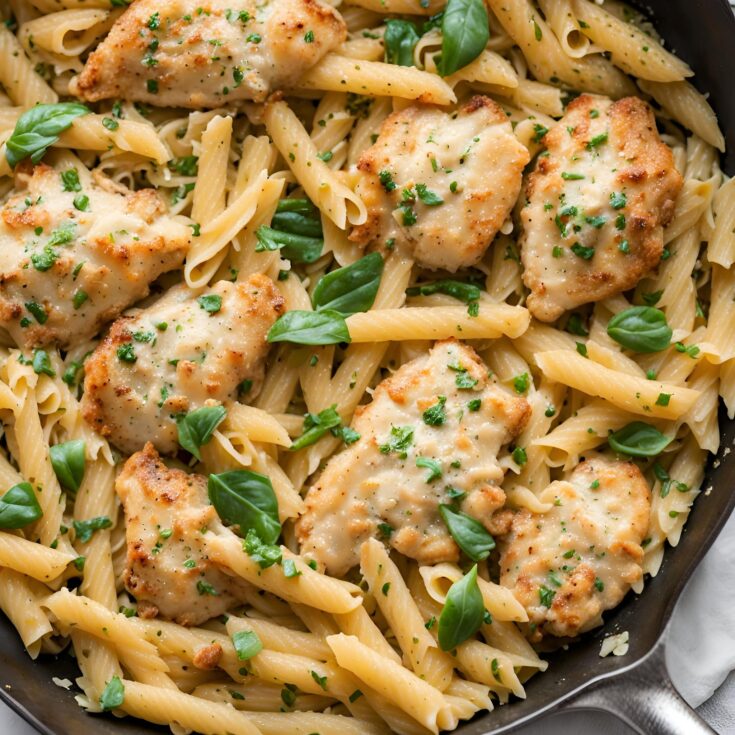Easy Garlic Parmesan Chicken and Pasta Recipe
Garlic Parmesan Chicken and Pasta is a comforting, crowd-pleasing dish that combines tender chicken, savory garlic, and rich Parmesan cheese with al dente pasta. It’s a meal that is both simple to prepare and bursting with flavor, making it a go-to recipe for busy weeknights, family dinners, and even special occasions.

The dish brings together the rich, creamy taste of Parmesan cheese with the robust flavor of garlic, creating a sauce that coats the pasta and chicken perfectly. The result is a delicious, satisfying meal that everyone will love.
Dietary Variations: Gluten-Free, Low-Carb, and More
If you have specific dietary needs, this recipe can easily be adapted:
- Gluten-Free: Use gluten-free pasta and ensure your Parmesan cheese is gluten-free.
- Low-Carb: Substitute the pasta with zucchini noodles or cauliflower rice.
- Dairy-Free: Use a non-dairy cream and vegan Parmesan cheese alternative.
Preparing Your Ingredients
Before you start cooking, it’s important to have all your ingredients prepared and ready to go. This not only makes the cooking process smoother but also ensures that each component is cooked to perfection.
How to Select the Best Chicken
For this recipe, boneless, skinless chicken breasts or thighs work best. Breasts will give you a leaner dish, while thighs offer more flavor and tenderness. Choose fresh, organic chicken if possible, as it tends to be juicier and more flavorful.
Preparing the Garlic: Minced, Sliced, or Crushed?
Garlic is a key ingredient in this dish, and how you prepare it can impact the flavor:
- Minced Garlic: Provides a strong, evenly distributed garlic flavor.
- Sliced Garlic: Adds a milder, sweeter flavor as the slices cook and caramelize.
- Crushed Garlic: Gives a more intense, slightly bitter taste, which works well in a creamy sauce.
Use about 4-6 cloves of garlic for a robust flavor, adjusting according to your preference.
Choosing the Right Parmesan Cheese
Freshly grated Parmesan cheese is ideal for this recipe. It melts better and has a stronger flavor than pre-grated varieties. If possible, use Parmigiano-Reggiano for an authentic taste, but any high-quality Parmesan will work.
Picking the Perfect Pasta
The type of pasta you use can change the texture and experience of the dish. Fettuccine and spaghetti are classic choices that hold the sauce well. Penne or rigatoni are also great options if you prefer pasta that can hold sauce inside each piece. Cook the pasta al dente, as it will continue to cook slightly when combined with the sauce.
Cooking the Chicken
Cooking the chicken properly is crucial to achieving a tender, juicy texture. Here’s how to do it:
Seasoning the Chicken
Start by seasoning the chicken with salt, pepper, and any additional herbs or spices you like. A simple seasoning blend allows the garlic and Parmesan to shine, but you can also add Italian seasoning, paprika, or a pinch of cayenne pepper for extra flavor.
Methods for Cooking: Searing, Grilling, or Baking
There are several ways to cook the chicken, depending on your preference and available equipment:
- Searing: Heat a skillet over medium-high heat with a mix of butter and olive oil. Sear the chicken for about 4-5 minutes per side until golden brown and cooked through. This method gives the chicken a nice crust while keeping the inside juicy.
- Grilling: For a smoky flavor, grill the chicken over medium heat for 6-7 minutes per side. Grilling adds a charred taste that complements the creamy sauce.
- Baking: If you prefer a hands-off approach, bake the chicken in a 375°F (190°C) oven for 20-25 minutes, depending on thickness. Baking is a great option if you’re cooking for a crowd.
Tips for Achieving Juicy and Flavorful Chicken
- Avoid Overcooking: Use a meat thermometer to ensure the chicken reaches an internal temperature of 165°F (74°C) without going over.
- Rest the Chicken: Let the chicken rest for 5 minutes after cooking to allow the juices to redistribute, ensuring a moist bite every time.
- Cut Against the Grain: When slicing the chicken, cut against the grain for the most tender results.
Making the Garlic Parmesan Sauce
The sauce is the star of this dish, bringing together the flavors of garlic, Parmesan, and cream in a rich, velvety blend.
Ingredients for the Sauce
- 2 tbsp butter
- 4-6 cloves garlic, minced
- 1 cup heavy cream or half-and-half
- 1 cup chicken broth
- 1 cup grated Parmesan cheese
- Salt and pepper to taste
Step-by-Step Guide to Creating a Smooth and Creamy Sauce
- Sauté the Garlic: In the same skillet used to cook the chicken, add butter and melt over medium heat. Add the minced garlic and sauté until fragrant, about 1-2 minutes. Be careful not to burn the garlic, as it can turn bitter.
- Add the Chicken Broth: Pour in the chicken broth, stirring to combine with the garlic and butter. Let it simmer for 2-3 minutes, reducing slightly.
- Incorporate the Cream: Slowly add the heavy cream, stirring constantly to avoid curdling. Bring the mixture to a gentle simmer, cooking for another 3-4 minutes until the sauce thickens slightly.
- Stir in the Parmesan: Gradually add the grated Parmesan cheese, stirring until fully melted and the sauce is smooth. If the sauce is too thick, you can thin it with a little more chicken broth or cream.
Adjusting the Sauce for Different Textures
- Thicker Sauce: Let the sauce simmer longer to reduce and thicken.
- Thinner Sauce: Add a splash of pasta water or more chicken broth to achieve your desired consistency.
- Extra Creamy Sauce: Add an extra tablespoon of butter or a splash of additional cream for an even richer sauce.
Cooking the Pasta
Pasta is the perfect companion to the garlic Parmesan sauce and chicken. Cooking it just right is key to the overall dish.
Choosing the Right Pasta Shape
The shape of the pasta can impact how well it holds the sauce. Long, flat noodles like fettuccine or linguine are excellent for creamy sauces, while short, ridged pastas like penne or rigatoni can capture the sauce in their grooves.
Tips for Cooking Pasta Perfectly Al Dente
- Use Plenty of Water: Bring a large pot of salted water to a rolling boil before adding the pasta. Using enough water ensures that the pasta cooks evenly and doesn’t stick together.
- Cook According to Package Instructions: Start checking the pasta a minute or two before the time indicated on the package to ensure it is al dente—firm to the bite but cooked through.
- Reserve Pasta Water: Before draining the pasta, reserve a cup of the starchy cooking water. This can be used to adjust the sauce’s consistency later.
How to Properly Drain and Toss Pasta
Once the pasta is al dente, drain it in a colander. If you’re not combining the pasta with the sauce immediately, toss it with a little olive oil to prevent sticking. For best results, add the drained pasta directly to the sauce while it’s still hot.
Combining the Chicken, Pasta, and Sauce
Bringing together the chicken, pasta, and sauce is where the magic happens. This final step ensures that every bite is bursting with flavor.
Mixing the Pasta with the Sauce
Once the pasta is drained, add it to the skillet with the garlic Parmesan sauce. Use tongs or a pasta fork to gently toss the pasta, ensuring every strand is coated in the creamy sauce. If the sauce is too thick, add a bit of the reserved pasta water until you reach the desired consistency.
Adding Chicken to the Pasta
Slice the cooked chicken into strips or bite-sized pieces, then add it to the pasta and sauce. Toss everything together, making sure the chicken is evenly distributed throughout the dish.
Ensuring Even Distribution of Ingredients
Take your time mixing the ingredients so that every forkful includes a bit of chicken, pasta, and sauce. This not only ensures a balanced flavor but also creates a more visually appealing dish.
Finishing Touches
To elevate your Garlic Parmesan Chicken and Pasta, consider adding some finishing touches that will enhance both the flavor and presentation.
Garnishing with Fresh Herbs
A sprinkle of fresh parsley, basil, or chives adds a pop of color and a burst of fresh flavor. Simply chop the herbs finely and scatter them over the top of the dish before serving.
Adding Extra Parmesan Cheese
For cheese lovers, a little extra grated Parmesan on top of the finished dish is a must. You can also use shaved Parmesan for a more elegant presentation.
Optional Additions: Red Pepper Flakes, Lemon Zest, or Cracked Black Pepper
- Red Pepper Flakes: If you like a bit of heat, sprinkle red pepper flakes over the top.
- Lemon Zest: A touch of lemon zest adds brightness and complements the richness of the sauce.
- Cracked Black Pepper: Freshly cracked black pepper adds a slight bite and enhances the overall flavor.
Serving Suggestions
Garlic Parmesan Chicken and Pasta is a versatile dish that can be served on its own or with a variety of side dishes.
Pairing with Side Dishes: Garlic Bread, Salad, and More
- Garlic Bread: Serve with warm, crusty garlic bread to soak up the creamy sauce.
- Salad: A simple green salad with a light vinaigrette balances the richness of the pasta.
- Roasted Vegetables: Roasted asparagus, Brussels sprouts, or zucchini make excellent side dishes.
Wine Pairings for Garlic Parmesan Chicken and Pasta
A crisp white wine like Chardonnay or Pinot Grigio pairs beautifully with the creamy sauce. For red wine lovers, a light Pinot Noir or Chianti complements the garlic and Parmesan without overpowering the dish.
How to Serve for Family Dinners or Special Occasions
Serve the dish family-style in a large, decorative bowl, allowing everyone to help themselves. For special occasions, you can plate individual servings, garnished with extra Parmesan and fresh herbs.
Storing and Reheating Leftovers
Garlic Parmesan Chicken and Pasta can be stored and reheated, making it a great option for meal prep or leftovers.
Proper Storage Techniques for Freshness
Store leftovers in an airtight container in the refrigerator for up to 3 days. The flavors will meld even more as the dish sits, making it even tastier the next day.
Best Methods for Reheating Without Drying Out
Reheat the dish gently on the stovetop over low heat, adding a splash of cream or chicken broth to loosen the sauce. Alternatively, you can microwave it in short intervals, stirring between each interval to ensure even heating.
Freezing Tips for Longer Storage
If you want to freeze the dish, it’s best to do so before adding the pasta. Freeze the chicken and sauce together in an airtight container for up to 3 months. When ready to serve, thaw, reheat, and cook fresh pasta to combine with the sauce.
Variations on Garlic Parmesan Chicken and Pasta
There are many ways to adapt this recipe to suit your tastes or dietary needs.
Creamy Garlic Parmesan Chicken and Pasta
For an extra creamy version, increase the amount of heavy cream and Parmesan cheese in the sauce. You can also stir in a little cream cheese for added richness.
Spicy Garlic Parmesan Chicken and Pasta
To add a spicy kick, increase the amount of red pepper flakes and consider adding a pinch of cayenne pepper or hot sauce to the sauce.
Garlic Parmesan Chicken and Vegetable Pasta
Incorporate your favorite vegetables into the dish for added color and nutrition. Spinach, broccoli, or cherry tomatoes work particularly well with the garlic Parmesan sauce.
Healthier Alternatives
For those looking to enjoy this dish with fewer calories or carbs, there are several healthier alternatives.
Low-Calorie Garlic Parmesan Chicken and Pasta
Use a low-fat cream or milk in place of heavy cream, and reduce the amount of Parmesan cheese. You can also use a whole-wheat or legume-based pasta for added fiber and nutrients.
Keto-Friendly Version with Zucchini Noodles
Substitute the pasta with zucchini noodles (zoodles) for a low-carb, keto-friendly version. The zucchini noodles hold up well to the creamy sauce and offer a lighter, fresher take on the dish.
Gluten-Free Garlic Parmesan Chicken and Pasta
Simply swap out regular pasta for your favorite gluten-free pasta variety. Be sure to check that your Parmesan cheese and chicken broth are also gluten-free.
Troubleshooting Common Issues
Even the best recipes can have hiccups. Here are some common issues and how to fix them:
Sauce Too Thick or Too Thin
- Too Thick: Thin the sauce with a little more chicken broth or pasta water.
- Too Thin: Simmer the sauce longer to reduce and thicken it, or add more Parmesan cheese.
Chicken Too Dry or Undercooked
- Too Dry: Make sure not to overcook the chicken. If it’s already dry, serving it with extra sauce can help.
- Undercooked: Return the chicken to the skillet or oven until it reaches an internal temperature of 165°F (74°C).
Pasta Overcooked or Underseasoned
- Overcooked: Rinse the pasta under cold water immediately after cooking to stop the cooking process. Unfortunately, overcooked pasta can’t be undone, so aim to check it frequently while boiling.
- Underseasoned: Season the pasta water generously with salt before cooking to ensure the pasta is well-flavored.
Frequently Asked Questions (FAQs)
Here are some common questions about making Garlic Parmesan Chicken and Pasta:
Can I Make This Recipe Ahead of Time?
Yes, you can prepare the sauce and chicken ahead of time and store them in the refrigerator. Cook the pasta fresh before serving to ensure the best texture.
What Can I Substitute for Parmesan Cheese?
If you don’t have Parmesan, Pecorino Romano or Grana Padano are good substitutes. For a milder flavor, you can use a mix of Parmesan and mozzarella.
How Can I Make This Dish Dairy-Free?
Use a non-dairy cream (such as coconut cream) and a vegan Parmesan cheese substitute to make the dish dairy-free.
Can I Use a Different Protein Instead of Chicken?
Yes, shrimp, turkey, or even tofu can be used in place of chicken. Adjust the cooking time accordingly to avoid overcooking the protein.
Easy Garlic Parmesan Chicken and Pasta Recipe

Garlic Parmesan Chicken and Pasta is a comforting, crowd-pleasing dish that combines tender chicken, savory garlic, and rich Parmesan cheese with al dente pasta. It’s a meal that is both simple to prepare and bursting with flavor, making it a go-to recipe for busy weeknights, family dinners, and even special occasions.
Ingredients
- For the Chicken:
- 1 tbsp avocado oil or olive oil
- 1 lb boneless, skinless chicken breast butterflied or beaten down to about ½" thickness
- 1 tbsp italian seasoning
- ½ tsp paprika
- salt & pepper to taste
- For the Pasta:
- 1 tbsp avocado oil or olive oil
- 1 tbsp unsalted butter
- ½ jumbo yellow onion diced (1 cup)
- 4-6 large cloves garlic minced
- 8 oz dry penne pasta normal or gluten free
- 2 cups chicken broth
- 1 cup finely grated parmesan cheese
- ½ cup heavy cream
- 2 tbsp chopped parsley
Instructions
- In a small bowl, mix together the italian seasoning, paprika, salt & pepper. Pat the chicken dry and then rub both sides with the seasoning mixture.
- 1 tbsp italian seasoning,½ tsp paprika,salt & pepper,1 lb boneless, skinless chicken breast
- Bring a large pan to medium heat. Once hot, add avocado oil. Then, add seasoned chicken and cook for 4-5 minutes per side, until the internal temperature reaches 165F. Remove chicken from the pan and set it aside to rest.
- 1 tbsp avocado oil
- Reduce heat to medium-low and add more avocado oil and butter. Then, add onion and season it with salt. Cook, stirring occasionally, for about 3 minutes, or until beginning to get tender and translucent. Add garlic, stir, and cook for 1 minute longer.
- 1 tbsp avocado oil,1 tbsp unsalted butter,½ jumbo yellow onion,4-6 large cloves garlic
- Deglaze the pan with chicken broth, scraping up all the browned bits stuck to the bottom. Allow the broth to come to a light boil. Then, add the dry pasta and stir to make sure that the pasta is submerged in the broth.
- 2 cups chicken broth,8 oz dry penne pasta
- Cover the pan and cook for 10 minutes or until the pasta is al-dente.
- Turn off the heat and add in the parmesan, heavy cream and parsley. Stir until the parmesan is melted and the sauce is warm. Taste and adjust salt and pepper as needed.
- 1 cup finely grated parmesan cheese,½ cup heavy cream,2 tbsp chopped parsley
- Slice the cooked chicken into strips and add it into the pan along with the pasta. Toss to combine. Then, serve & enjoy!



